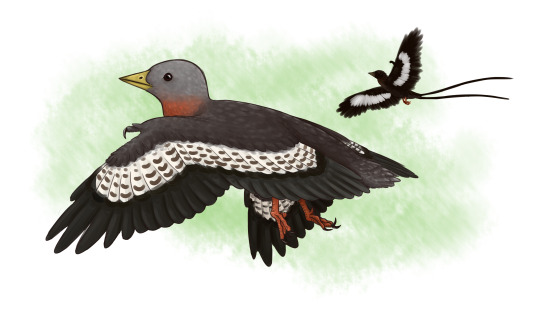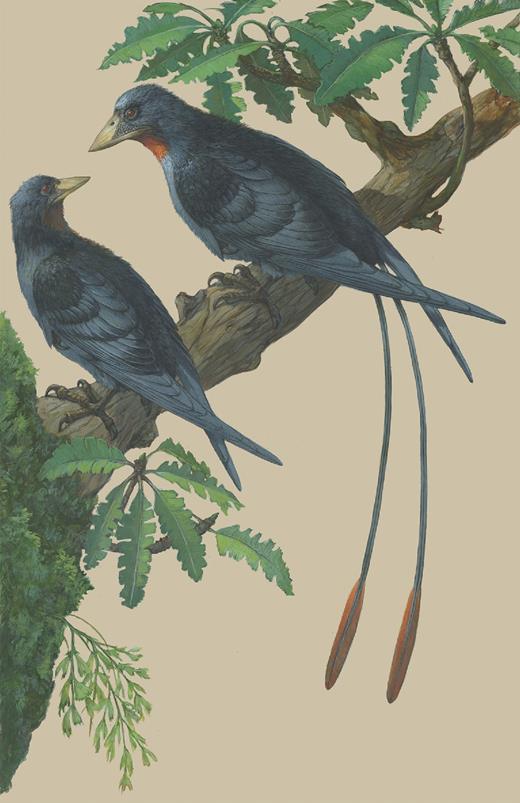#eoconfuciusornis zhengi
Explore tagged Tumblr posts
Text
Eoconfuciusornis zhengi

By Scott Reid on @drawingwithdinosaurs
PLEASE SUPPORT US ON PATREON. EACH and EVERY DONATION helps to keep this blog running! Any amount, even ONE DOLLAR is APPRECIATED! IF YOU ENJOY THIS CONTENT, please CONSIDER DONATING!
Name: Eoconfuciusornis zhengi
Name Meaning: Dawn Confucius Bird
First Described: 2008
Described By: Zhang, Zhou & Benton
Classification: Dinosauria, Theropoda, Neotheropoda, Averostra, Tetanurae, Orionides, Avetheropoda, Coelurosauria, Tyrannoraptora, Maniraptoriformes, Maniraptora, Pennaraptora, Paraves, Eumaniraptora, Averaptora, Avialae, Euavialae, Avebrevicauda, Pygostylia, Confuciusornithiformes
Eoconfuciusornis is an Avialan that lived about 131 million years ago, in the Haquterivian age of the Early Cretaceous - making it older than Confuciusornis, its relative, leading to its name. It had a pointed, toothless snout, but this snout was probably not homologous (meaning, having the same evolutionary origin) as modern bird beaks, given that many birds more derived than Eoconfuciusornis retained teeth. It is, however, the oldest known Avialan to have a beak. It is from the Dabeigou Formation in Hebei Province, China, and it is known multiple fairly complete skeletons, including a female in the early process of generating new eggs. Eoconfuciusornis was smaller than Confuciusornis, and it had longer legs and lacked a crest on the humerus, unlike Confuciusornis.

By Michael Rothman, taken from Zheng et al. 2017.
It is the most early derived member of the Confuciusornis family group (which is called Confuciusornithidae or Confuicusornithiformes, depending on the context, so I’m just going to keep calling it the family group.) It had a triangular head, and pointed but broad wings, indicated it was well built for gliding, as well as ribbon tail feathers that would probably have been used for display, seeing as they were sexually dimorphic. Some coloration is known from the fossil female, which does not preserve the ribbon feathers (indicating the aforementioned sexual dimorphism); it’s difficult to completely construct the coloring, but the females were probably mostly black, with a brown throat patch, grey head and legs, and darkly spotted wings.
Source:
https://en.wikipedia.org/wiki/Eoconfuciusornis
Martyniuk, M. P. 2012. A Field Guide to Mesozoic Birds and other Winged Dinosaurs. Pan Aves; Vernon, New Jersey.
Zheng, X., J. K. O’Connor, X. Wang, Y. Pan, Y. Wang, M. Wang, Z. Zhou. 2017. Exceptional preservation of soft tissue in a new specimen of Eoconfuciusornis and its biological implications.
Shout out goes to @jamieraptor!
#eoconfuciusornis#eoconfuciusornis zhengi#dinosaur#bird#palaeoblr#birblr#jamieraptor#paleontology#prehistory#prehistoric life#dinosaurs#biology#a dinosaur a day#a-dinosaur-a-day#dinosaur of the day#dinosaur-of-the-day#science#nature#factfile#Dìneasar#דינוזאור#डायनासोर#ديناصور#ডাইনোসর#risaeðla#ڈایناسور#deinosor#恐龍#恐龙#динозавр
94 notes
·
View notes
Text
I paleontologi trovano il fossile di un uccello col becco di 119 milioni di anni fa
I paleontologi trovano il fossile di un uccello col becco di 119 milioni di anni fa
Ricostruzione dell’uccello confuciusornitiforme Eoconfuciusornis zhengi del primo Cretaceo. Una nuova specie di uccello confuciusornitide, denominata Confuciusornis shifan, è stata identificata da uno scheletro quasi completo rinvenuto nella Cina nordorientale. Confuciusornis shifan visse nell’attuale Cina durante il primo Cretaceo, circa 119 milioni di anni fa. La nuova specie apparteneva a…

View On WordPress
0 notes
Link
An article published in the journal "Proceedings of the National Academy of Sciences" describes a research on a bird that lived about 130 million years ago called Eoconfuciusornis zhengi. A team of researchers from North Carolina State University, Chinese Academy of Sciences and Linyi University have found in this bird's known fossil specimen traces of keratin and melanosomes and managed to prove that these are traces of its feathers.
0 notes
Link
Un articolo pubblicato sulla rivista "Proceedings of the National Academy of Sciences" descrive una ricerca su un uccello vissuto circa 130 milioni di anni fa chiamato Eoconfuciusornis zhengi. Un team di ricercatori della North Carolina State University, dell'Accademia cinese delle Scienze e della Linyi University hanno trovato nell'esemplare fossile conosciuto di quest'uccello tracce di cheratina e melanosomi e sono riusciti a provare che si tratta di tracce delle sue penne.
0 notes